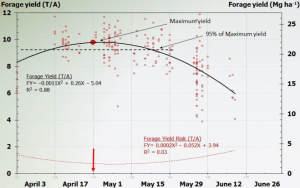Joe Lauer, University of Wisconsin – Madison
We have written quite a bit about planting date effects on corn grain yield (high moisture and dry corn). What about its effects on corn silage? As planting date becomes more delayed, there is an increased likelihood that fields intended for grain will be harvested for silage, especially if the year remains cool.

Figure 1. Corn forage yield response of full-season hybrids (104-108 RM) to planting date during 2003 to 2012 at Arlington, WI (N= 235 plots).
The grain yield response of full-season hybrids to planting date at Arlington for the last 10 years has been described previously. These treatments were established using 8-row plots; four rows were harvested for silage Continue reading



